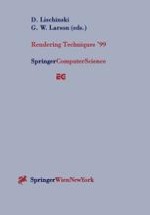This book contains the proceedings of the 10th Eurographics Workshop on Rendering, which took place from the 21st to the 23rd of June, 1999, in Granada, Spain. Origi nally an outgrowth of the annual Eurographics meeting, the workshop was organized by a dedicated group of researchers who felt there was insufficient opportunity at Eu rographics and Siggraph to exchange ideas specifically on rendering. Over the past 9 years, the workshop has become renown as an international watershed for top quality work in this field, attracting between 50 and 100 attendees each year to share their latest research. This year we received a total of 63 submissions. Each paper was carefully reviewed by two of the 25 international programme committee members, as well as two external reviewers, selected by the co-chairs from a pool of 71 individuals. (The programme committee and external reviewers are listed following the contents pages.) In this new review process, all submissions and reviews were handled electronically, with the ex ception of videos submitted with a few of the papers. This streamlined the review process considerably, while reducing the costs and confusion associated with courier delivery of hundreds of papers.
